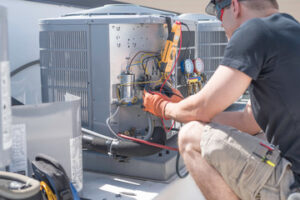HVAC system moves air throughout a home or building. It moves air through a network of ducts and is designed to regulate temperature and humidity. The air is routed to different parts of the home and used for a variety of purposes. The air may be used to remove dust or moisture from the air, reduce humidity and heat, or cool the building.
Heating and HVAC are the systems that regulate temperature, humidity, and the quality of the air in a building. These systems provide thermal comfort and acceptable indoor air quality. They utilize various technologies to control temperature, humidity, and the purity of air. This allows for greater efficiency and reduces costs. HVAC systems are crucial for residential and commercial buildings.
A typical HVAC system consists of a heating unit, a cooling unit, and a duct for moving heated air throughout the building. The heating unit is usually a furnace. The efficiency of a furnace is measured by its Annual Fuel Utilization Efficiency (AFUE) rating. Furnaces with an AFUE rating of 80% or higher are considered energy efficient.
To choose the right HVAC system for your home, first, consider the size of your building and climate. This will allow your contractor to calculate the amount of heat and air your house needs. This will ensure that your system is powerful enough for your home while still providing good airflow to every room. An HVAC system that is well-designed and installed will maintain just the right temperature in all rooms and operate quietly in the background.
Heating and HVAC is a complicated processes with many moving parts. These systems provide warmth during the winter months and cool the home in the summer. They also clean the air to prevent harmful pollutants. In addition, they keep your home comfortable year-round. A combination of heating and cooling products and a distribution system are what makes up a modern HVAC system.
When you hire an HVAC contractor, make sure you ask about their licensing and insurance. State laws may vary slightly, but you should always ask to see these credentials before signing any contracts. If your contractor does not have this information, you should not hire them for your project. This way, you can be sure that you’re hiring a reliable and qualified contractor.
Some HVAC systems can be connected to your home’s thermostat through the use of an internet connection. These systems allow you to program your HVAC components. They can also be linked to an indoor air quality device that monitors air quality. These devices can be very effective at reducing the overall cost of energy in your home.
Humidification is an important factor in the design and maintenance of HVAC systems. Modern codes require engineers to incorporate humidity into the design of HVAC systems in buildings. In addition, some products have humidity tolerances and need to be kept within these limits to ensure that they perform properly and are covered under warranty. Therefore, it is important for engineers and architects to work together to specify the proper humidification system capacity and controls.
A humidification system should be installed in a room where it will not be disturbed by other HVAC equipment. If the furnace is located in a closet, this might not be possible. It should also have access to a floor drain. It is not a good idea to run a drain line outdoors because it can freeze over in winter.
Healthcare facilities have special requirements when it comes to humidity control. It is critical to control air moisture in order to protect patients and staff from harmful bacteria and viruses. As a result, humidification is an important part of commercial HVAC systems and is essential to good facilities management. Humidification can be achieved through isothermal or adiabatic processes.
In addition to regulating the humidity, humidification can also help control the growth of bacteria. Many bacteria and fungi thrive in moist environments. These bacteria can be found in a variety of materials, including wood, paper, paint, soft furnishings, and soil in plant pots. They are also found in dust and cooked foods.

